|
|
 |
Fiche d'espèce de Copépode |
|
|
Calanoida ( Ordre ) |
|
|
|
Arietelloidea ( Superfamille ) |
|
|
|
Heterorhabdidae ( Famille ) |
|
|
|
Heterorhabdus ( Genre ) |
|
|
| |
Heterorhabdus spinosus Bradford, 1971 (F,M) | |
| | | | | | | Syn.: | Heterorhabdus austrinus : Bradford, 1970 (part., p.347);
Heterorhabdus (Heterorhabdus) spinosus : Bradford-Grieve,1999 b (p.88, figs.F,M, Rem., figs.175, 191) | | | | Ref.: | | | Bradford, 1971 a (p.121, figs.F,M); Park, 2000 (p.130, figs.F,M, Rem.) | 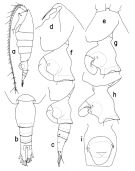 issued from : T. Park in Bull. Scripps Inst. Oceanogr. Univ. California, San Diego, 2000, 31. [p.252, Fig.100]. Female: a, habitus (left side); b, c, urosome (dorsal, left, respectively); d, e, forehead (left, dorsal, respectively); f, genital somite (left); g, genital somite with operculum partially open (left); h, genital somite with operculum fully open (left); i, genital somite (ventral). Nota: - Prosome 71 % length of body and about 2.3 times length of urosome. - Cephalosome 45 % length of prosome. - Posterolateral corner of prosome broadly rounded, overlapping anterior 1/10 length of genital somite. - Urosome 31 % length of body. - Length ratios of 4 urosomal somites and left caudal ramus 37.1 : 18.3 : 13.7 : 8.8 : 22.3 = 100. - Left caudal ramus extending beyond posterior end of right ramus by 1/6 its length as measured along medial margins. Dorsal appendicular seta of left caudal ramus a little longer than that of right ramus. Anteriorly, each caudal ramus with 3 pores. - A1 extending beyond posterior end of caudal ramus by its last 2 segments. - All cephalosomal appendages similar to those of H. hadrosoma except for Mx2. - Swimming legs similar to those of H. hadrosoma except for P5.
|
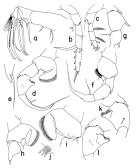 issued from : T. Park in Bull. Scripps Inst. Oceanogr. Univ. California, San Diego, 2000, 31. [p.253, Fig.101]. Female: a, left Mx2 (posterior); b, P5 (endopod omitted), posterior; c, P5 (exopod omitted), anterior. Nota female: - Mx2: Posterior subterminal spine of 4th lobe about 1/5 length of 2nd saberlikespine, which is a little longer than 1st; falcate spine of 5th lobe about 1/3 times length of saberlike spine, with proximal 47% of medial margin finely serrated with short spinules; falcate spine of 6th lobe with proximal 63% of medial margin serrated with relatively long spinules. Male: d, right P5 (endopod omitted), anterior; e, distal end of exopod of right P5 (lateral); f, left P5 (anterior); g, exopod of left P5 (anterior); h, i, basipod of right P5 (anterior, posterior, respectively); j, spiniles on basal lobe of right P5; k, l, second exopodal segment of right P5 (anterior, posterior, respectively).
|
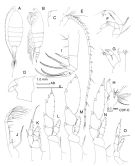 issued from : J.M. Bradford-Grieve in The Marine Fauna of New Zealand: Pelagic Calanoid Copepoda. National Institute of Water and Atmospheric Research (NIWA). NIWA Biodiversity Memoir, 111, 1999. [p.72, Fig.39]. Female: A, habitus (dorsal); B, idem (left lateral side); C, rostrum (left side); D, genital somite (left lateral side); E, A1; F, A2; G, Md; H, Mx1; I, Mx2; J, Mxp; K, P1; L, P2; M, P3; N, P4; O, P5.
|
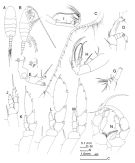 issued from : J.M. Bradford-Grieve in The Marine Fauna of New Zealand: Pelagic Calanoid Copepoda. National Institute of Water and Atmospheric Research (NIWA). NIWA Biodiversity Memoir, 111, 1999. [p.73, Fig.40]. Male: A, habitus (dorsal); B, idem (right lateral side); C, left A1; D, A2; E, left Md; F, terminal part of right mandible blade; G, Mx1; H, Mx2; I, Mxp; J, P1; K, P2; L, P3; M, P4; N, P5.
|
 issued from : J.M. Bradford in N.Z. Jl mar. freshw. Res., 1971, 5 (1). [Fig.2, p.124]. Female genital segment of three Heterorhabdus species. H. norvegicus: a, dorsal view; b, left side; c, right side. H. austrinus: d, dorsal view; e, left side; f, right side. H. spinosus: g, dorsal view; h, left side; i, right side; j, dorsal view contracted specimen; k, left side contracted specimen. Nota: There may be considerable variation in the shape and length of the female genital segment of three species, dependent on whether the ventral genital segment flap is open or closed and the degree of longitudinal muscle contraction which may radically alter the shape of the genital segment.
|
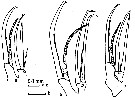 issued from : J.M. Bradford in N.Z. Jl mar. freshw. Res., 1971, 5 (1). [p.125, Fig.3]. Lobes 4 and 5 of Mx2 from female of three Heterorhabdus female. a: H. norvegicus; b: H. austrinus; c: H. spinosus.
|
 issued from : J.M. Bradford in N.Z. Jl mar. freshw. Res., 1971, 5 (1). [p.125, Fig.4]. P5 of male of three Heterorhabdus species. a: H. norvegicus; b: H. austrinus; c: H. spinosus.
|
 Heterorhabdus spinosus Heterorhabdus spinosus female: 1 - See key to species groups of Heterorhabdus: ''abyssalis'' Group (p.90, 114). 2 - Genital somite without a conical projection mediodorsally (Fig.100-a, c). 3 - Laterally, genital somite without a tubercular outgrowth posteriorly on dorsal margin (Fig.100-c). 4 - Laterally, genital operculum reaching close posterior end of somite (Fig.100-c). 5 - Laterally, genital flange short and high, distinctly separate from posterior ventral margin of somite (Fig.100-f). Posterior subterminal spine of 4th lobe of Mx2 about 1/5 length of 2nd saberlike spine (Fig.101-a).
|
 Heterorhabdus spinosus Heterorhabdus spinosus male: 1 - See key to species groups of Heterorhabdus: ''abyssalis'' Group (p.90, 114). 2 - Basis of left P5 without a well-developed inner lobe (Fig.101-f). 3 - Basal inner lobe of right P5 armed with thick lancet like bristles (Fig.101-j).
|
 issued from : J.M. Bradford in N.Z. Jl mar. freshw. Res., 1971, 5 (1). [p.122, Table 1): Differences between H. norvegicus, H. autrinus and H. spinosus.
| | | | | Ref. compl.: | | | Hsiao & al., 2004 (p.326, tab.1); Dur & al., 2007 (p.197, Table IV); Park & Ferrari, 2009 (p.143, Table 5, 7: common deep water species, 8, Appendix 1, biogeography) | | | | NZ: | 4 | | |
|
Carte de distribution de Heterorhabdus spinosus par zones géographiques
|
| | | | | |  Carte de 1996 Carte de 1996 | |
| | | | Loc: | | | W South Africa, Tasman Sea & sub-Antarct., E New Zealand, off Chilean coast, China Seas ( South China Sea), Taiwan (SW, E); [no Medit. in Kovalev & Shmeleva, 1982, p.84; Razouls & Durand, 1991, p.75]
Type locality: 41°47'S, 175°01'E.
For Park (2000, p.131) is taken from off the west coast of South Africa in the southeastern Atlantic between 33°47' S and 31°09' S; from off the Chilean coast in the southeastern Pacific between 46°55' S and 35°10' S; from off the east coast of New Zealand at 41°26' S, 176°04' E; in the Tasman Sea at 49°39' S, 152°34' E and 40°06' S, 152°00' E, respectively. According to these findings and the previous record, this species has a circumsubantarctic distribution.
After Hsiao & al. (2004, p.329) thie species is new to the East region of Taiwan. | | | | N: | 5 | | | | Lg.: | | | (399) F: 4,2-3,4; M: 3,7-3,1; (824) F: 4,4-3,84; M: 3,8-3,32; {F: 3,40-4,40; M: 3,10-3,80} | | | | Rem.: | "Abyssalis" Group.
Voir aussi les remarques en anglais | | | Dernière mise à jour : 17/10/2017 | |
|
|
 Toute utilisation de ce site pour une publication sera mentionnée avec la référence suivante : Toute utilisation de ce site pour une publication sera mentionnée avec la référence suivante :
Razouls C., Desreumaux N., Kouwenberg J. et de Bovée F., 2005-2025. - Biodiversité des Copépodes planctoniques marins (morphologie, répartition géographique et données biologiques). Sorbonne Université, CNRS. Disponible sur http://copepodes.obs-banyuls.fr [Accédé le 19 octobre 2025] © copyright 2005-2025 Sorbonne Université, CNRS
|
|
 |
 |









